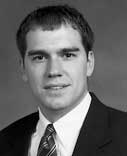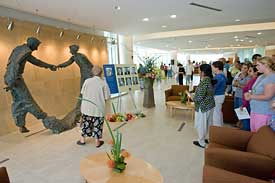A week of tremendous emotion for the U-M community stemming from the loss of the Survival Flight transplant team turned the grand opening of the new U-M Cardiovascular Center into a bittersweet celebration.

With hundreds of guests and U-M Health System (UMHS) staff looking on, University officials and dignitaries gathered on stage June 7 and took turns memorializing staff killed in a plane crash three days earlier, while marking the opening of the new building.
“We are all grieving for our colleagues and for the pain this tragedy is causing their loved ones and friends,” said President Mary Sue Coleman during the ceremony in the west courtyard of the new center at Ann and Observatory streets.
Dr. Robert Kelch, executive vice president for medical affairs, led the crowd in a moment of silence to honor the crash victims. “Our celebration today is dedicated to our Survival Flight family whom we lost so tragically earlier this week,” he said. They were killed when their plane bound for Willow Run Airport from Milwaukee, carrying organs for transplant, crashed around 4:50 p.m. June 4 in Lake Michigan.
Aboard the aircraft were:
• Dr. David Ashburn, a resident in thoracic surgery
• Richard Chenault II, a transplant donation specialist with the U-M Transplant Program
• Dennis Hoyes, a Marlin Air pilot
• Rick Lapensee, a transplant donation specialist with the U-M Transplant Program
• Bill Serra, a Marlin Air pilot
• Dr. Martinus (Martin) Spoor, cardiac surgeon on the U-M faculty
“The life-saving work of Survival Flight and our transplant teams brings hope and optimism to our patients and their families,” Coleman said. “And it is that spirit, that faith in a healthier tomorrow, which buoys us in our dedication of the Cardiovascular Center.”
The new center
The five-story, 350,000-square-foot center includes a large clinic area for outpatient diagnosis and treatment, 19 operating and procedure rooms, 48 inpatient rooms and amenities including a cafe, auditorium and indoor gardens. Skybridges and tunnels connect it to the main University Hospital and C.S. Mott Children’s Hospital, and it has its own 465-space parking garage.

It is the new home for most UMHS adult heart and vascular care, although care will continue to be provided in areas of University Hospital and outpatient centers, such as Domino’s Farms.
As guests entered the sun-drenched courtyard area, two members of the group Mass Ensemble performed on harp strings stretched from a ground-level stage to the top of the five-story building. Also performed was music commissioned specially for the event, “Fanfare for Brass and Percussion” composed by Michael Daugherty, professor in the School of Music, Theatre & Dance. Among speakers on hand to celebrate the opening of the new center was U-M graduate and former surgeon general Dr. Antonia Novello, who proclaimed, “It will become the best of its kind—Watch out Cleveland Clinic.”
Master of ceremonies, Dr. Sanjay Gupta, U-M graduate, CNN medical news correspondent and chief of neurosurgery at Grady Memorial Hospital in Atlanta, Ga., said, “Those who died Monday are six soldiers, six heroes, in the war against disease. And we of course all are enlisted in the same cause.”
The tragedy
The U-M transport team was called at 7:30 a.m. June 4 to assemble and at 10:20 a.m. drove from the Health System to Willow Run Airport. They left Willow Run on the Cessna jet at 11:10 a.m. and arrived in Milwaukee at 11:50 a.m. After a successful donor operation, the Cessna jet and crew left Milwaukee at 4:45 p.m. Investigators say the crash happened some five minutes later.
Authorities investigating the crash said that after takeoff the pilot sent an emergency signal indicating he wanted to turn the jet around. Within moments air traffic controllers reported the plane disappeared from radar.
The Coast Guard began search and rescue efforts soon after the plane went down. Officials called off the search for the flight crew around 7 a.m. June 5 after determining that the impact of the crash and the temperature of the water made it unlikely there were survivors. The National Transportation Safety Board has since been trying to determine the cause of the crash. Severe weather and high winds have hampered efforts to find parts of the aircraft that may help with the investigation.
Crew remembered
Tributes to the fallen colleagues began pouring in almost immediately on the UMHS Web site, and from colleagues. “I travel each year to your Survival Flight conference in Ann Arbor,” posted Laura Evans. “You are all such a tight-knit family, that makes everyone else feel the energy and commitment that you share. My deepest sympathy for your losses.”
Rosalie Hammon in her message recalled Ashburn 12 years ago as a “high-spirited graduate research assistant that loved to play practical jokes on folks” in Los Alamos, N.M.
At a press conference June 6 at the North Campus Administration Building, Dr. Jeffrey Punch, director of the division of transplantation at the Medical School, remembered watching Chenault taking a walkway from University Hospital to C.S. Mott Children’s Hospital, carrying a container with an organ ready for donation. “I remember one time he saw a family member and he offered, ‘Would you like to walk over with me?'”
“Martin Spoor was in two of my OJOC classes that I taught,” wrote Trivellore Raghunathan in his posting. “Always cheerful, very unassuming and many times wearing his cowboy boots. What I remember most was his unique sense of humor … He will come down to me during the break and ask me a question and would drop in these one liners that made you chuckle, a very welcome relief during the long OJOC teaching hours. I am so happy that I got to know him.”
Transplant performed
Kelch reported to UMHS staff June 8 that the 50-year-old Michigan man who was awaiting transplant when the Survival Flight crew went down had received a new set of donor lungs June 7. “We’re so grateful this transplant has happened,” said a family member who asked to remain anonymous. “We were devastated and heartbroken when we learned about the crash on Monday—not only for our family member, but for the families of those wonderful men who gave their lives to help him.” Kelch added, “Recovery from a double-lung transplant is an arduous process, but the surgery was successful and the patient is doing well.”
Colleagues cope with loss
Peter Forster, chief department administrator with the Department of Emergency Medicine, said, “This is the worst day of my professional career this week.”
Punch said the Survival Flight program is continuing in an effective manner. “We did a transplant this morning,” he said June 6. Punch said several other hospitals had offered transplant transport staff since the crash. “We have not needed to take advantage of those offers,” he said. “We have additional surgeons that are trained and experienced.”
Dr. Mark Lowell, medical director of Survival Flight, said of staff, “The amazing thing is they want to get right back on that horse (fly), that is their passion.
“It just casts a pall over the business. It will take a long time.”
“I feel strongly that I have lost members of my family,” said Denise Landis, manager of critical care transport for Survival Flight. “We are a very close knit group. The tragedy has affected us deeply.”
More information on the crash victims, memorial services and remembrances is at www.med.umich.edu/survival flight/update.
Family Memorial Funds
Members of the campus community and beyond have asked about contributing to memorial funds to honor Survival Flight plane crash victims. The following funds had been established as of Record press time June 8:
• David Ashburn Memorial Fund: National City, 8123 Main St. Dexter, MI 48130
• Rick Lapensee Memorial Fund: Bank of Ann Arbor, 7 W. Michigan Ave., Ypsilanti MI 48197
• Richard Chenault Memorial Fund: Midwest Financial Credit Union, PO Box 130079 Ann Arbor, MI 48113-0079 (Please make checks payable to Janet Chenault/Chenault Fund.)
• Spoor Children’s Fund: A fund has been set up for the Spoor children*s education. Make a donation via the Spoor Family Web site: www.sitemaker.umich.edu/spoorfamily.
• U-M Transplant Team Assistance Fund: The University has established this fund to help the families of the six courageous men who devoted their lives to helping others. Make a donation by downloading and mailing or faxing the PDF form accessible on www.med.umich.edu/survival_flight/update/fund.htm, or by calling (734) 998-8851 or toll-free: (800) 468-3482.
Go to www.med.umich.edu/survival_flight/update/fund.htm for updates and new information.

